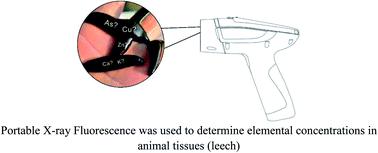当前位置:
X-MOL 学术
›
J. Anal. At. Spectrom.
›
论文详情
Our official English website, www.x-mol.net, welcomes your feedback! (Note: you will need to create a separate account there.)
Elemental assessment of dried and ground samples of leeches via portable X-ray fluorescence
Journal of Analytical Atomic Spectrometry ( IF 3.4 ) Pub Date : 2020-08-13 , DOI: 10.1039/d0ja00328j Shubin Zhou 1, 2, 3, 4 , Qiuming Cheng 1, 2, 3, 4 , David C. Weindorf 5, 6, 7 , Zhaoxian Yuan 4, 8, 9, 10 , Biying Yang 1, 2, 3, 4 , Qun Sun 4, 11, 12, 13 , Zhenjie Zhang 1, 2, 3, 4 , Jie Yang 1, 2, 3, 4 , Molei Zhao 1, 2, 3, 4
Journal of Analytical Atomic Spectrometry ( IF 3.4 ) Pub Date : 2020-08-13 , DOI: 10.1039/d0ja00328j Shubin Zhou 1, 2, 3, 4 , Qiuming Cheng 1, 2, 3, 4 , David C. Weindorf 5, 6, 7 , Zhaoxian Yuan 4, 8, 9, 10 , Biying Yang 1, 2, 3, 4 , Qun Sun 4, 11, 12, 13 , Zhenjie Zhang 1, 2, 3, 4 , Jie Yang 1, 2, 3, 4 , Molei Zhao 1, 2, 3, 4
Affiliation

|
Determination of elemental concentrations in animal tissues is critically important due to the extensive use of animal tissues in food and medicine. Traditionally, elemental analysis has mostly relied on laboratory-based methods, such as inductively coupled plasma atomic emission spectrometry (ICP-AES) and inductively coupled plasma mass spectrometry (ICP-MS). Portable X-ray fluorescence (XRF) spectrometry, which has been widely applied in soil and rock analysis, has rarely been used to quantify elements in animal tissues. In this pilot study, the effectiveness of using pXRF to determine elemental concentrations in leeches was demonstrated. The effects of the moisture content and compaction (density) on pXRF readings were experimentally quantified. The penetration depth of X-rays in leech samples is generally <15 mm. For leech samples with different thicknesses (thicknesses ranging from 2.5 mm to 15 mm), measured pXRF elemental concentrations were found to decrease with increasing sample thickness in a power function, the square of the correlation coefficient (R2) of which was 0.96 and 0.89 for Zn and Fe, respectively. Therefore, the thickness correction for intermediate sample thickness is possible in future analysis, enabling a more accurate analysis for samples with insufficient sample mass. The detection limits determined for As and Cu in dried and ground leech samples with a thickness of ∼15 mm were ∼5 and ∼20 mg kg−1, respectively, which were equal to/lower than the regulatory limits for both food and medicine. The pXRF measured concentrations of S, K, Fe, Cu, Zn, and As were highly correlated with ICP results (R2 ≥ 0.92), with the exception of Ca (R2 = 0.81). Simple linear regression models were employed to predict the ICP-based elemental composition of 15 leech samples using pXRF elemental data as inputs; the validation results were quite good for all the studied elements (R2 ≥ 0.92). Thus, pXRF shows great potential for safety control of elemental concentrations in food and medicine.
中文翻译:

通过便携式X射线荧光对水lee干和磨碎样品进行元素评估
由于动物组织在食品和药品中的广泛使用,确定动物组织中元素的浓度至关重要。传统上,元素分析主要依靠基于实验室的方法,例如电感耦合等离子体原子发射光谱法(ICP-AES)和电感耦合等离子体质谱法(ICP-MS)。便携式X射线荧光(XRF)光谱技术已广泛应用于土壤和岩石分析,很少用于量化动物组织中的元素。在该初步研究中,证明了使用pXRF确定水ches中元素浓度的有效性。实验中量化了水分含量和压实度(密度)对pXRF读数的影响。X射线在水ech样本中的穿透深度通常小于15毫米。Zn和Fe的R 2)分别为0.96和0.89。因此,在将来的分析中可以对中间样品厚度进行厚度校正,从而可以对样品量不足的样品进行更准确的分析。在干燥和磨碎的水ech样品中,厚度约为15 mm的砷和铜的检出限分别为5和20 mg kg -1,这等于/低于食品和药品的监管限值。S,K,铁,铜,锌,和As的pXRF测得的浓度用ICP结果(结果高度相关- [R 2 ≥0.92),与Ca的异常(- [R 2= 0.81)。使用简单的线性回归模型,以pXRF元素数据作为输入来预测15个水le样品中基于ICP的元素组成;验证结果对于所有研究的元素(相当好- [R 2 ≥0.92)。因此,pXRF在安全控制食品和药品中的元素浓度方面显示出巨大的潜力。
更新日期:2020-08-13
中文翻译:

通过便携式X射线荧光对水lee干和磨碎样品进行元素评估
由于动物组织在食品和药品中的广泛使用,确定动物组织中元素的浓度至关重要。传统上,元素分析主要依靠基于实验室的方法,例如电感耦合等离子体原子发射光谱法(ICP-AES)和电感耦合等离子体质谱法(ICP-MS)。便携式X射线荧光(XRF)光谱技术已广泛应用于土壤和岩石分析,很少用于量化动物组织中的元素。在该初步研究中,证明了使用pXRF确定水ches中元素浓度的有效性。实验中量化了水分含量和压实度(密度)对pXRF读数的影响。X射线在水ech样本中的穿透深度通常小于15毫米。Zn和Fe的R 2)分别为0.96和0.89。因此,在将来的分析中可以对中间样品厚度进行厚度校正,从而可以对样品量不足的样品进行更准确的分析。在干燥和磨碎的水ech样品中,厚度约为15 mm的砷和铜的检出限分别为5和20 mg kg -1,这等于/低于食品和药品的监管限值。S,K,铁,铜,锌,和As的pXRF测得的浓度用ICP结果(结果高度相关- [R 2 ≥0.92),与Ca的异常(- [R 2= 0.81)。使用简单的线性回归模型,以pXRF元素数据作为输入来预测15个水le样品中基于ICP的元素组成;验证结果对于所有研究的元素(相当好- [R 2 ≥0.92)。因此,pXRF在安全控制食品和药品中的元素浓度方面显示出巨大的潜力。


























 京公网安备 11010802027423号
京公网安备 11010802027423号